Thai Culture and Thai Traditions
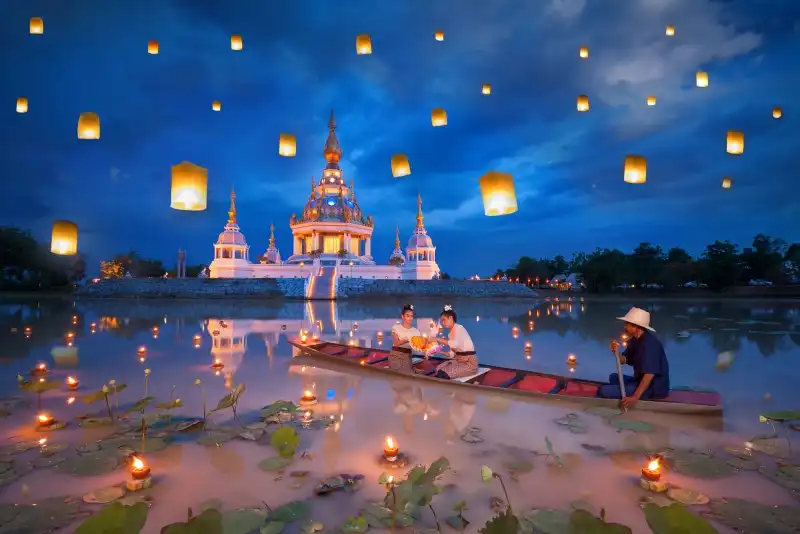
Rating: 2.4/5 (41 votes)
Chiang Mai attractions
Attractions in Thailand
Thai Culture and Thai Traditions The word culture has its roots in Latin, Cultura, and English uses the word Culture. Thailand has coined the word culture to be used in 1940, during the government of Field Marshal Plaek Pibulsongkram by Professor Major General Chao Boromwongtha. Krom Muen Narathip Pongpraphan for the first time coined the word Pruitthi Dharma to use first.
When he saw that it was not popular to use, he changed to use the word culture, which is a word that has melodious and meaningful in accordance with English subjects This word is accepted and used. widespread and still in use today
Culture is something created by man. established without acting on instinct To use in their own society, and culture will appear in the form of systems of thinking (Thinking), doing (Doing) and having (Having), which are all man-made and concocted.
World culture is the Universal Declaration of Human Rights. It consists of 6 fundamental rights:
1. The right to self-determination
2. The right to prevent discrimination race and skin color
3. Women's rights
4. Youth Rights
5. Prohibition of forced or compulsory labor
6. Human rights in service, justice, protection of the accused, imprisonment or detention. These 6 aspects are all related to the way of life. people of all races Different races, religions, beliefs, etc., which is the standard of human society. Humans who are members of the global community must act together.
National culture is a diversity of ethnic groups. that differ in skin color, appearance, beliefs, traditions and way of life, including the combination of living styles that live together in society have to act in certain ways together by having laws, ministerial regulations, rules and regulations that are to be treated with each other must act together.
Folk culture is the way of life of different tribes. living together in the country But there are appearances, skin colors, races, livelihoods, religions, beliefs, customs and traditions that are different. but live together in which country One country is diverse. But there is a way of living. and similar identities.
There are four components of culture
1. There is a concept (Concept) or a philosophy (Philosophy) that originates from the belief in the myth. An environment that is rational or has principles and academic principles as a base. But most of them are derived from religion and nature or called the consensus.
2. There are symbols (Symbols) that convey meaning to cause can understand each other, such as language, gestures, dress, marks, pictures, melodies, rhythms, actions, number systems, and including objects man made Or called the object.
3. Be Organized (Organization) a unit of culture is born. from the integration of cultural characteristics step by step This includes organizing the structure. control to be in normal condition And set a pattern of behavior as a standard for everyone in society to recognize together, sometimes called an organization.
4. Utilization (Usage) is used to benefit society and practitioners Expressed in the form of various rituals such as the ordination ceremony, the ceremony to pay homage to teachers, as well as following the traditions in society. Sometimes called the ceremony.
Type of culture
1. Material culture (Material Culture) refers to the material culture. It is a culture that can be touched with shape. Or are things that humans invent to use in their lives, such as houses, food, tools, appliances, medicines, etc.
2. Non-material culture (Non-material Culture) refers to the abstract culture as Culture that cannot be touched includes language, speech, ideas, values, traditions, beliefs held by human beings about religion, political ideology, this kind of culture sometimes included sports rules Player proficiency or competitors, concepts about the competitors' tactics, including the behavior that is the origin of the competitors and the administrators of the competition as well as social etiquette.
Importance of culture
1. Culture protects people and protects society.
2. Culture sets the norm. or a way of living The coexistence of human beings has a culture, so there is a pattern of living in order to live together in peace.
3. Culture creates identity for society.
4. Creative culture Promote values, mold personality of members of society.
5. Culture creates national security.
Traditions are things that human beings have established for the welfare of human beings. Social life will not be peaceful. If there is no backing tradition, the tradition of the society is not It is a certain thing that is fixed or cannot be changed. contrary to tradition can occur and disintegrate when the social environment changes, knowledge and understanding of nature expands invention more broader science Having contact with other societies has different ways. needs and opportunities to make life comfortable Need to find a new way In accordance with the environment, when it is accepted, it will become a new tradition. Improvements to suit social conditions change the tradition Types of Thai traditions can be divided into 3 types:
1. Customs or moral rules (Mores) refer to traditions that everyone must follow. If any person disobeys, no refrain Acts are considered wrong and evil. Customs are related to the morality of common people in society And that can be seen in Thai society, including the expression of gratitude that children should have towards their fathers. mother when you are old It's the duty of the child. will take care of If the child does not take care of society, it will be punished as being unfilial. Considered evil, no one wants to be with. customs or moral rules of each Society is not the same. Thai society sees that there is a sexual relationship. Before marriage it was against the custom, but the Swedes saw it as normal.
2. Traditions or institutions (Institution) is a tradition that sets a direct order, like a law. Or various regulations, which are clearly laid down as a formality or to know each other without placing a formal order that How should they behave?
3. Tradition or tradition (Convention) refers to various practices in daily life that are practiced. Until I get used to it, it's normal. It is about ordinary situations that are not It is of great importance to the welfare or needs of a society, or is it something everyone practices in general until it becomes a habit or a common standard in that society. Traditions originated without anyone knowing or caring. Investigate the exact history, such as how to dress. How to welcome friends Violators are punished informally or indirectly but not severely or serious in any way, for example, may be gossiped or ridiculed, etc.
Important traditions in Thailand can be divided into 3 types:
1. Family traditions The merit-making has been done since ancient times, including daily morning alms giving, birthday alms giving, festival days, or special merit-making dates.
For example, making merit, opening a building, office, etc. Making merit by giving alms to monks gives 3 benefits:
- It is the merit of the alms-giver.
- Trained to be selfless and share.
- Helping monks and novices.
2. Family traditions making merit for monks Making merit as usual is often done on important occasions such as birthday anniversary, building a new house, opening a new office, celebrating the end of the old year and welcoming the new year. There must be a group of altar tables, asanas, monks. In this ceremony, there will be an offering of precepts. Arathana Praparit Sang Charoen Phra Phutthamon.
Ordination: A man aged 7 years and over, Buddhists will ordain as a novice, called "Ordination", at the age of 20, will be ordained as a monk. will observe 227 precepts.
3. Social traditions or festivals social traditions or festivals It is an organized tradition. Year-round and distributed locally. provinces and regions across the country.
State Ceremonies and Ceremonies State Ceremonies are national ceremonies that are undertaken by the government for a specific purpose. according to the nature of the work The ceremonial states that are regularly scheduled according to the royal calendar are:
-State ceremony to pay homage to King Naresuan at the royal monument
- State Ceremony to commemorate Maha Chakri Day
- State Ceremony to Pay homage to the King's Memorial King Rama VI is in Elegance in the era similar to the day of death
- State ceremonies on constitution day and paid homage to the royal monument King Prajadhipok
- State Ceremony on the Day of King Taksin the Great
- State Opening Ceremony of Parliament
A royal ceremony means a ceremony in which the King performs royal duties. According to the royal traditions that have existed since ancient times or His Majesty's initiatives to be made The royal ceremonies that have been set as annual events in the royal calendar of King Rama IX are as follows:
- New Year's ceremony
- Royal Sacrifice Ceremony
- The Royal Ceremony for Changing the Garments of the Buddha Maha Manee Rattana Patimakorn 3 Seasons
- The Royal Worship Ceremony
- Songkran ceremony
- Thaksinanupadana royal merit-making ceremony and coronation ceremony
- Makha Bucha Royal Ceremony
- Royal Plowing Ceremony
- Royal merit-making ceremony on Vasak Bucha Day
- Royal charity on the day of the cremation of the Lord Buddha
- Royal merit Thaksinanupada presents the ashes of His Majesty the King Chanok and the day of the death of His Majesty King Ananda Mahidol
- The Royal Ceremony of the Naga Royal Ordination Ceremony
- Royal merit-making ceremonies on Asalha Bucha Day and the Buddhist Lent festival
- Royal ceremony to celebrate the birthday of Her Majesty the Queen
- Sart Royal Ceremony
- Royal merit-making ceremony offering Kathina robes
- Royal merit-making ceremony on Chulalongkorn Day
- Royal ceremony to celebrate the birthday of His Majesty the King
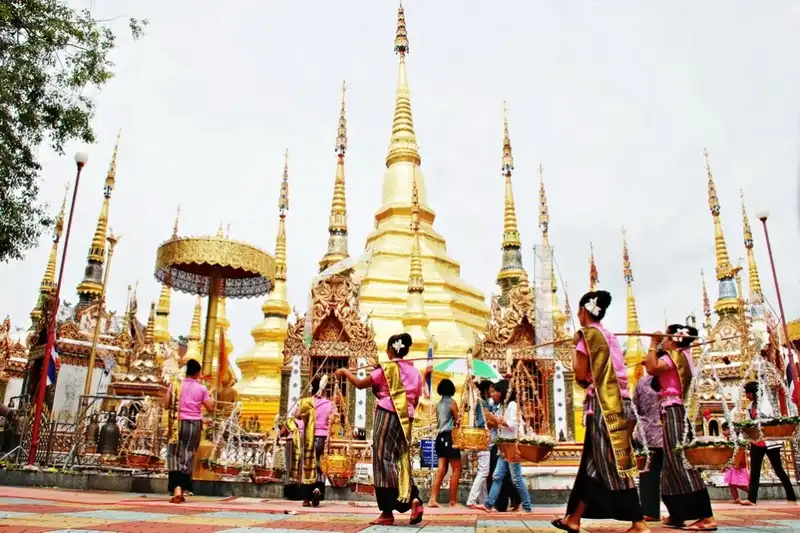
Northern culture Northern area of Thailand It has borders with Burma, China and Lao People's Democratic Republic. on the administrative side The northern region consists of 15 provinces, namely Phitsanulok, Phichit, Kamphaeng Phet, Tak, Sukhothai, Phrae, Nan, Uttaradit, Phetchabun, Lampang, Lamphun, Chiang Mai, Chiang Rai, Phayao and Mae Hong Son. There are still some specific characteristics that are different, for example, Phitsanulok, Phichit, Sukhothai, and Kamphaeng Phet, often called the upper central region. because the culture has similar to the central region Mae Hong Son province has a culture that is characterized as a group of Thai Yai mixed with Burmese, Phetchabun, which tends to the northeastern region. That is actually a northern cultural group, namely, Lampang, Lamphun, Chiang Mai, Chiang Rai, and Phayao. This group of provinces is called Muang or Yuan or Thai Yuan, which means Yonok. Phrae and Nan provinces have their own characteristics as well.
Most of the northern people have a career in farming, farming, most of the farming is in the black field. Northern people grow sticky rice mostly. Because consuming glutinous rice Sticky rice is of good quality, soft and soft, appetizing. The famous rice variety is San Pa Tong rice. and also grow other field crops such as onions, garlic, beans, tobacco, etc. Having a career in gardening is also popular. Especially gardening longan and lychee. There is another occupation which is the culture of the northern people, namely making miang. Northern people like to eat betel nut and betel leaf. by taking the leaves of the young leaves to ferment It has a sour and astringent taste. when fermented for a long time When taking Miang leaves to suck then mix it with table salt or stuff Eat other things as you like besides eating Miang Lanna people, both women and men, smoke cigarettes wrapped in banana leaves. One roll is the size of a finger. and almost creeping in length Villagers call this type of cigarette "Yo-Yo" or "Yo-Yo" cigarettes that are popular because of the cold weather. smoking causes The body warms up and northerners still have other occupations. May be called a handicraft or The household industry was that the women would weave the fabrics after the rice fields were finished. There was also carving. making silverware, lacquerware, and ironware making, etc.
Lanna culture as well as being a link to Travel between regions to achieve the distribution of tourists. and distribute tourism income thoroughly in the northern region It also encourages cooperation. And develop tourism together between all provinces in the northern region as well
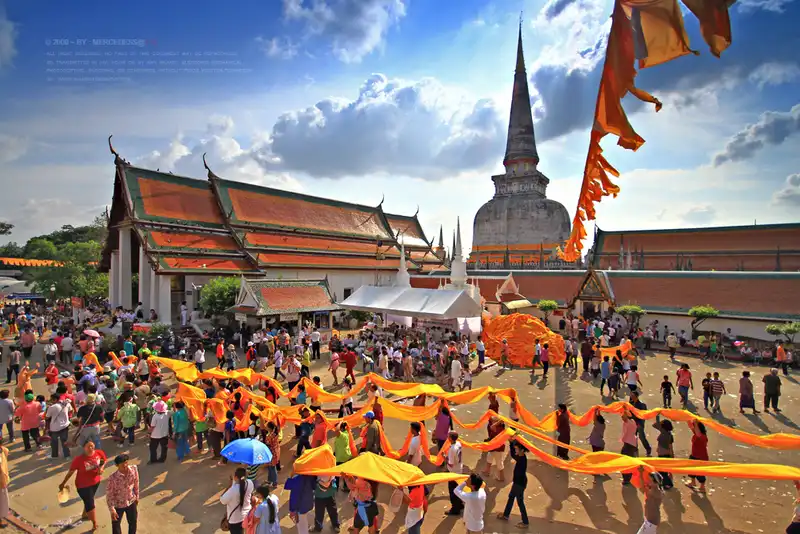
Southern Culture The South is a region of Thailand in the south of the country. Next down from the central region on the Indian Peninsula. It is flanked by the Gulf of Thailand on the east coast and the Andaman Sea on the west coast, covering a total area of 70,715.2 square kilometers. The length from north to south is about 750 kilometers. All provinces of the region have coastal areas. Except Yala province, most of the area is flat. There are important mountain ranges such as Tanaosri mountain range phuket mountain range Nakhon Si Thammarat mountain range The San Kala Khiri mountain range is the border between Thailand and Malaysia. The mountain ranges in the south are 1,000 kilometers long and short. The major rivers are the Phum Duang River, the Tapee River, the Pattani River, the Tha Thong River, the Takua Pa River. Pak Phanang River and the Trang River The beaches on the Gulf of Thailand are formed by high elevation, with long, smooth, wide coastal plains and shallow waters.
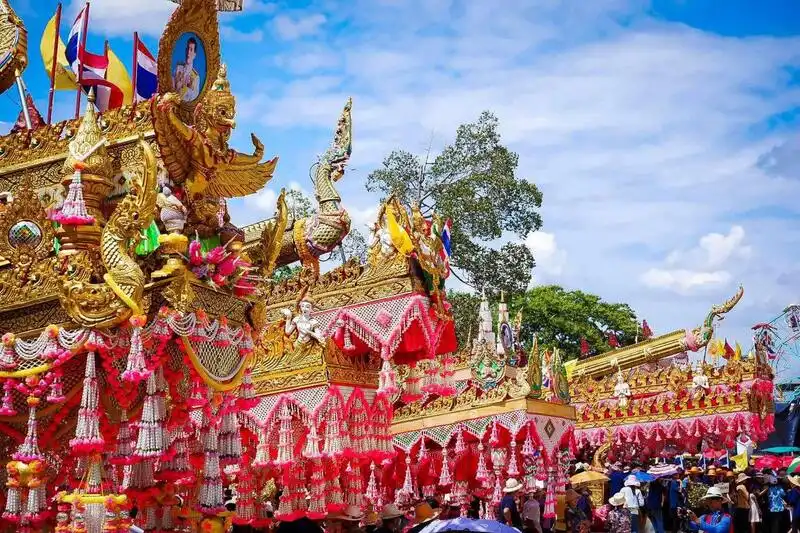
Northeastern culture Northeastern region or Northeastern region consists of 19 provinces, namely
Kalasin, Khon Kaen, Chaiyaphum, Nakhon Phanom, Nakhon Ratchasima, Buriram, Maha Sarakham, Mukdahan, Yasothon, Roi Et, Loei, Sisaket, Sakon Nakhon, Surin, Nong Khai, Nong Bua Lam Phu, Amnat Charoen, Udon Thani and Ubon Ratchathani have an area of approximately 170,226 square kilometers or 1 in 3 of the entire country. Located on the Khorat Plateau, the topography of both the elevation and the edge is clearly separated from the central region. It consists of high mountain ranges. west and south The western mountain range has an average height of 500-1,000 meters above sea level. The highest peak in the Northeast is Yod Phu Luang with a height of 1,571 meters and Phu Kradueng with a height of 1,325 meters. It is the source of many rivers such as the Phong River. The Loei River, the Phrom River, the Chi River and Lam Ta Khong River, the abundance of beautiful nature on many high mountain peaks, is the source of thousands of years of ancient civilizations that are of historical value. as well as local culture, simple way of life and the generosity of the Northeastern people It is still a charm that attracts tourists to visit Isaan continuously until now.
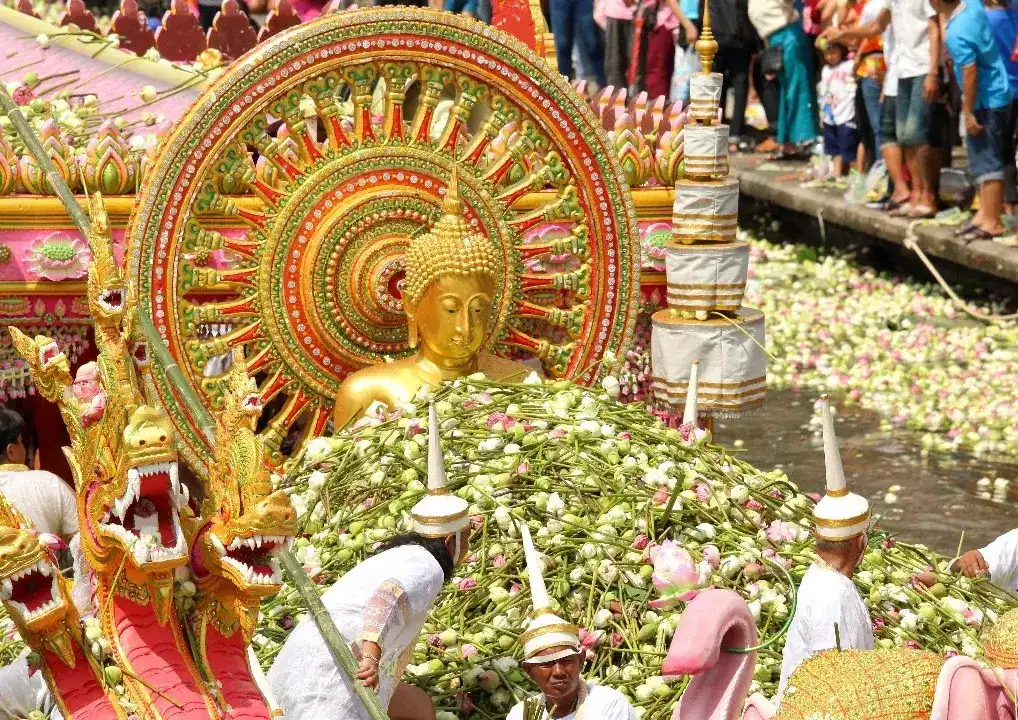
Central culture There are 22 provinces in the central region: Phitsanulok, Sukhothai, Phetchabun, Phichit, Kamphaeng Phet, Nakhon Sawan, Lop Buri, Chai Nat, Uthai Thani, Sing Buri, Ang Thong, Saraburi, Phra Nakhon Si Ayutthaya, Suphan Buri, Nakhon Nayok, Pathum Thani, Nonthaburi, Bangkok, Nakhon Pathom, Samut Prakan, Samut Sakhon and Samut Songkhram. Therefore, most people in the central region are engaged in agriculture. animal husbandry And fishing, both freshwater and saltwater fishing, as well as trading career, is another occupation that people in the central region are very popular because the central region There will be convenient transportation on both land and water, making it ideal for trading.
career in the central region Most of them are farming, but there are many other occupations such as corn, sorghum farming, vegetable gardening, orchards such as orange, pomelo, sweet tamarind, mango, fish farming, shrimp farming, pigs, beef cattle. Milk, broilers, laying hens, etc. There are also various industries, trade, service work, but they are all important occupations. Bangkok is a large city with a large population. Include all economic activities and at the same time include all kinds of problems such as slums. Crime, drugs, traffic jams Air and water pollution The central region therefore is the center of all aspects of the economy. Therefore, the average population in this district has a better living than the population in other districts. As the country began to produce more industrial output, expansion began in this sector and thus the current export value of Industrial produce exceeds the export value of agricultural produce. This does not mean that we are sending less agricultural products. Rather, it is the result of comparing the values between two groups of economic activities.
January
1. The tradition of the Pak Nam Pho Shrine Procession, Nakhon Sawan Province
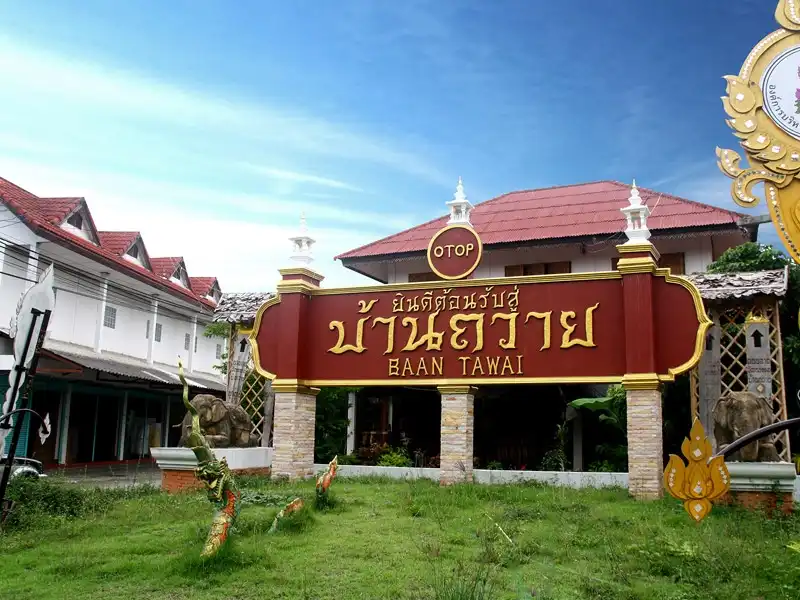
2. Ban Thawai wood carvings จัChiang Mai Province is considered one of the most famous cultural tourist destinations in Chiang Mai Province. It is well-known among both Thai and foreign tourists.
The origin of wood carving in Chiang Mai Province, which is why wood carving products are widely popular today, both in terms of value and quality of products. A gathering point for a variety of outstanding handicrafts, such as wood carving, line work – decoration, lacquer work – gilding, antiques, silverware, lacquerware, woven fabrics, wickerwork and pottery, etc.
3. Don Chedi Memorial and Charity Fair, Suphan Buri Province
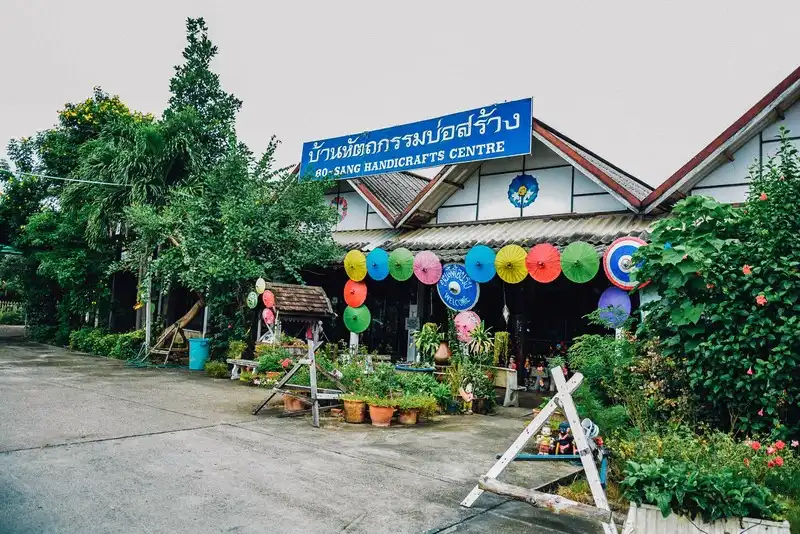
4. Both Thai and foreign tourists know it as a village that produces umbrellas, a local handicraft of Bo Sang. This coming event is the 24th time. This time, the executives of Ton Pao Subdistrict Municipality intend to make it bigger than ever before, organizing 16 consecutive activities from 19-21 January.
5. Red Cross Fair and Mukdahan Thai Ethnic Group Fair, Sweet Tamarind on the Mekong River, Mukdahan Province.
6. Nakhon Pathom Food and Fruit Festival, Nakhon Pathom Province.
7. The Thai Navy's Heroic Deeds Day in the Battle of Koh Chang, Trat Province.
February
1. The tradition of carrying cloth up to the pagoda in Nakhon Si Thammarat Province.
2. King Narai the Great's Land Festival, Lopburi Province.
3. Sweet Mango Day and the best of Nakhon Nayok, Nakhon Nayok Province.
4. Bang Rachan Camp Singburi Province Annual event on February 4-6 of every year at the Monument to the Heroes and Bang Rachan Camp Park. It consists of a ceremony to pay homage to the statue of Phra Ajahn Thammachot and lay wreaths to pay homage to the Monument to the Heroes, historical drama performances about the heroes of Bang Rachan Camp, as well as local performances, entertainment, and many exhibitions.
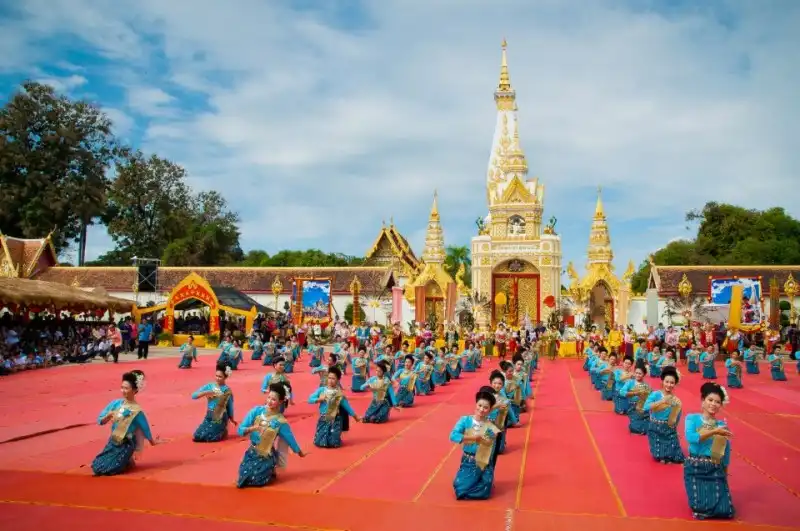
5. The Phra That Phanom worship festival in Nakhon Phanom Province is a long-standing tradition, from the 8th waxing moon of the 3rd lunar month to the 1st waning moon of the 3rd lunar month of every year, for a total of 9 days and 9 nights, to pay homage to the Lord Buddha and Phra That Phanom, which is a sacred place in the Northeast.
6. Lim Ko Niao Shrine Festival, Pattani Province On the 15th day of the waxing moon in the 3rd lunar month of every year, there will be a Lim Ko Niao Shrine Festival, which Pattani Province gives special importance to. This celebration is very grand, with people from other provinces in Thailand and neighboring countries traveling to come and pay homage to the goddess. Normally, the event is held for about 7 days and 7 nights, starting from the 8th day of the waxing moon in the 3rd lunar month. Many shops open to sell goods similar to other annual events. Two types of entertainment that are indispensable are Chinese opera and Manora. Chinese opera and Manora are performed on a permanent stage in front of the shrine.
7. Pong Lang Phraewa Festival and Charity Fair, Kalasin Province.
8. Boon Bek Fa and Red Cross, Maha Sarakham Province.
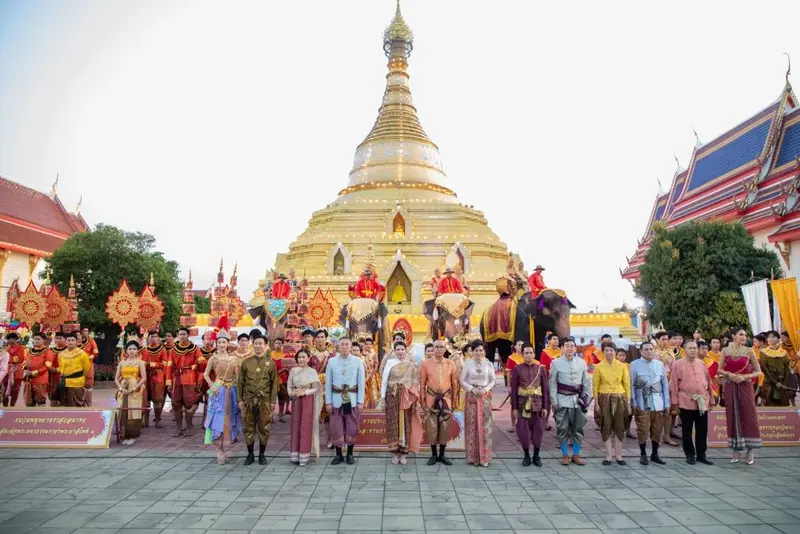
9. The tradition of paying homage to the Buddha and playing music and celebrating the world heritage in Kamphaeng Phet Province, during the full moon day of the third lunar month (around February-early March of every year), is a tradition inherited from Sukhothai. It is said that during the reign of King Lithai, the Buddha's relics were brought from Sri Lanka to be enshrined in the pagoda of Wat Phra Borommathat, Tambon Nakhon Chum. Therefore, a procession of the rulers was organized to pay homage to the Buddha's relics. The organization of the Phra Borommathat Paying Homage to Music Festival is an annual event of Kamphaeng Phet Province. It is a revival and dissemination of the original traditions that are passed on to the new generation to understand the history of their locality.
10. Phra That Cho Hae worship tradition, Phrae Province, Tung Luang procession, Phrae Province The event is held between the 11th waxing moon of the 6th month of the North (4th southern month) to the 15th waxing moon of the 6th month, a total of 5 days and 5 nights. Paying homage to Phra That Cho Hae is a belief that has been practiced and passed down that paying homage to a sacred place will bring good fortune and bring happiness and prosperity. On the last day of the event, people join together to bring food to make merit by offering food to the monks at the Phra That grounds. In the morning, some of the people who come to make merit by offering food may travel to Phra That Doi Leng to pay homage to the Phra That and see the beautiful scenery of the city. At night, people will join together to circumambulate the Phra That and the temple with candles. During the event, there will be entertainment every night.
11. The Phra Buddha Chinnarat Worship Festival in Phitsanulok Province is held from the 11th waxing moon of the 6th month in the North (4th southern month) to the 15th waxing moon of the 6th month, for a total of 5 days and 5 nights. The worship of Phra That Cho Hae is a belief that has been practiced and passed down that paying homage to a sacred place will bring good fortune and bring happiness and prosperity. On the last day of the festival, people join together to bring food to make merit by offering food to the monks at the Phra That grounds. In the morning, some of the people who come to make merit by offering food may travel to Phra That Doi Leng to pay homage to the Phra That and see the beautiful scenery of the city. At night, people will join together to circumambulate the Phra That and the temple with candles. During the festival, there will be entertainment every night.
12. Red Cross Fair, Cotton Flowers in Bloom, Sweet Tamarind of Loei Province.
13. Fang Nok Puppet Festival, Good Products Fair and Charity Fair, Chai Nat Province.
14. Sammok City Festival, Mae Hong Son Province.
15. Phra Nakhon Khiri Festival, Phetchaburi Province.
16. Flower and Ornamental Plant Festival, Chiang Mai Province.
17. Celebration of His Majesty King Phutthaloetla Naphalai's Birthday, Samut Songkhram Province.
18. Worshiping the Buddha's Footprint Tradition, Saraburi Province.
19. Lampang Elephant Festival, Lampang Province.
March
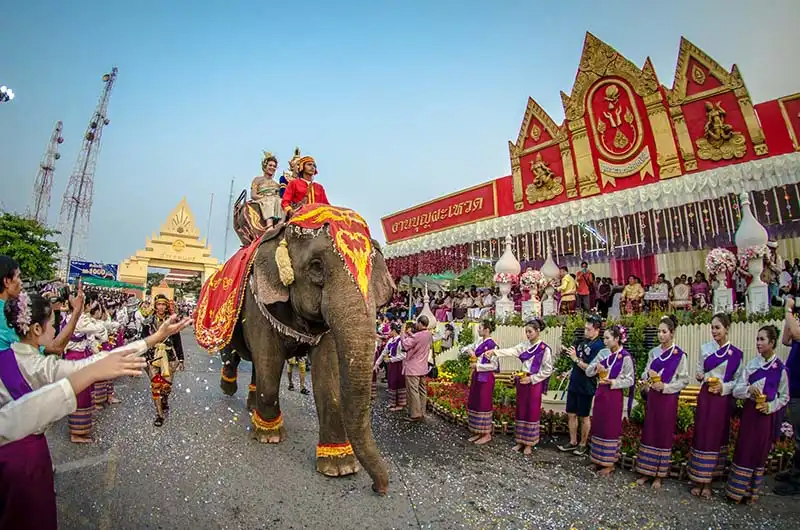
1. Bun Pha Wet Tradition, Roi Et Province, Time: Saturday of the first week of March. Bun Pha Wet or commonly known as Bun Maha Chat is a tradition of merit according to the twelve customs of the Isan people. However, if it is considered as a matter of charity, it is a tradition of great charity. It can be inferred from the general condition of the Isan people that Dok Jik and Dok Chan bloom around the beginning of the third month. Buddhists will collect these flowers to string into garlands to decorate the prayer hall for Bun Maha Chat and in this event there will be a Maha Chat sermon.
which is considered a sacred event. Whoever listens to the Mahachat sermon in one day and performs good deeds will receive merit to be born in the next life. It is a festival that all people should be interested in participating in and preserving and passing it on as a culture to the next generation who should see its value and preserve it as a culture. In addition, it is also a gathering between relatives from far away, in accordance with the saying, "Eat rice noodles, get merit from Pha Wet, listen to the Mahachat sermon."
which is considered a sacred event. Whoever listens to the Mahachat sermon in one day and performs good deeds will receive merit to be born in the next life. It is a festival that all people should be interested in participating in and preserving and passing it on as a culture to the next generation who should see its value and preserve it as a culture. In addition, it is also a gathering between relatives from far away, in accordance with the saying, "Eat rice noodles, get merit from Pha Wet, listen to the Mahachat sermon."
2. Bangkok International Kite Festival.
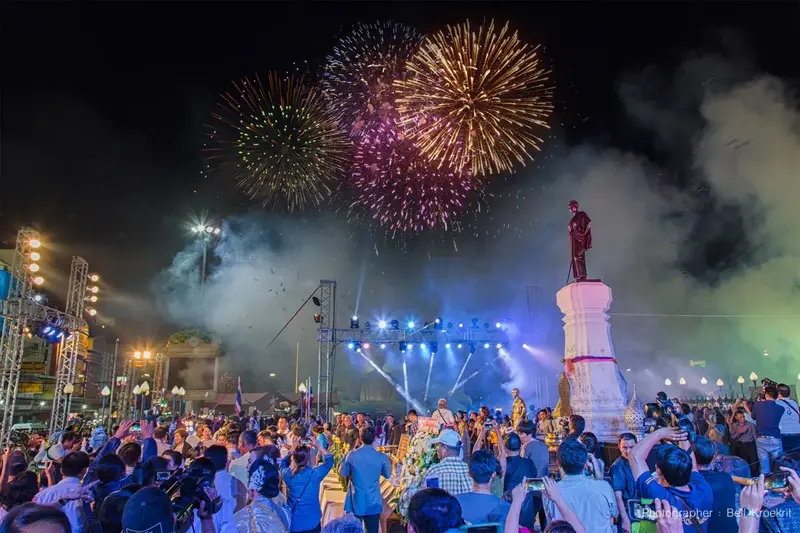
3. The celebration of Thao Suranari Victory Day, Nakhon Ratchasima Province The period is between March 23 - April 3 of every year. It is an annual event of the province which starts on March 23 of every year, which is considered the time when Thao Suranari (Khunying Mo) won the victory over the enemy. Because March 23, 2369 is the day that Chao Anuwong led his army out of Nakhon Ratchasima. Therefore, it is a traditional event to commemorate the bravery of that heroic act. In addition, there are cultural performances, booths, exhibitions by government agencies and private sectors, as well as entertainment activities that rotate every day. This activity aims to build morale and encouragement for citizens and be a role model for citizens to be aware of the people who are honored as venerable persons.
4. Chumphon Sea World Festival, Chumphon Province.
5. Ang Thong Rice Barn Festival.
6. Sisaket Thai Tribe Tradition and Lamduan Flower Festival, Sisaket Province.
7. Sea Turtle Conservation Festival, Phang Nga Province.
8. Trat Memorial Day, Trat Province.
9. Sweet Grape Week and Damnoen Saduak Floating Market, Ratchaburi Province.
10. ASEAN Java Sparrow Singing Competition, Yala Province.
April
1. The Phra Pradaeng Songkran Festival in Samut Prakan Province is a local traditional event of the Thai-Mon people. It is held every year on the Sunday after Songkran Day (April 13). The people of Phra Pradaeng organize this as a traditional event of the Mon people, with parades, fish releases, and the Saba game, which is considered a tradition that honors the image and is a symbol of the people of Phra Pradaeng.
2. Songkran traditions and Lanna Thai festivals in the past, Chiang Mai Province.
3. Songkran Festival Pattaya, Chonburi Province.
4. Rice Pile Tradition, Chonburi Province.
5. Thai Heritage Conservation Day and Nang Talung Championship, Pattani Province.
6. Poy Sang Long Tradition in Mae Hong Son Province is a tradition of ordaining novices according to the customs of the Tai Yai people to give children the opportunity to study the teachings of the Lord Buddha and to believe that they will receive merit from ordaining novices. This event is organized during March-April during the summer break. Villagers will agree on a date for their children to ordain together. The novices are decorated with beautiful valuable ornaments and the ordination ceremony is held at the temple that the hosts have faith in.
7. Songkran Festival, Golden Shower and Khaen Sound Festival, Khon Kaen Province.
8. Phanom Rung Mountain Climbing Tradition, Buriram Province.
9. Cantaloupe Day and Aran's best products, Sa Kaeo Province.
10. Songkran tradition of the Mon people, Nonthaburi Province.
11. The tradition of ordaining monks and parading the novices on elephants of the people of Hat Siao, Sukhothai Province.
12. Salung Luang tradition, Lampang Province.
May
1. Rocket Festival, Yasothon Province.
2. Fruit and Good Things Festival, Rayong Province.
3. The tradition of bathing the Hariphunchai Chedi in Lamphun Province.
4. Lychee Festival and Chiang Rai's Good Products, Chiang Rai Province.
5. Prachinburi Province Agricultural and Good Products Fair.
June
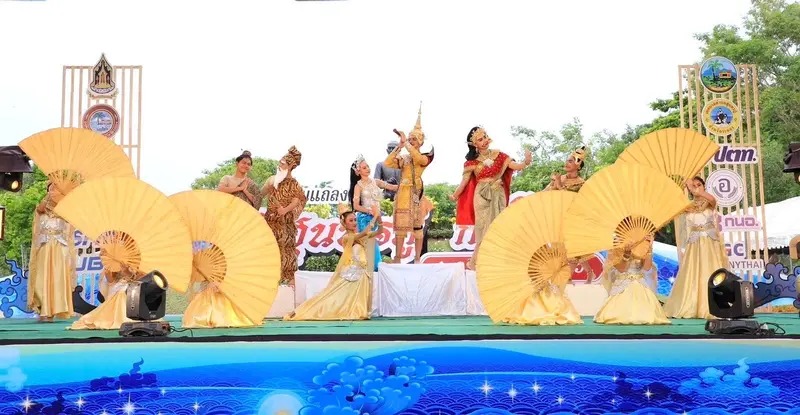
1. Sunthorn Phu Day, Rayong Province Tuesday, June 26 of every year is held to commemorate and pay tribute to Sunthorn Phu, Thailand's great poet.
2. Rocket Festival, Nong Bua Lamphu Province.
3. Sweet Rambutan and Trat Fruit Day, Trat Province.
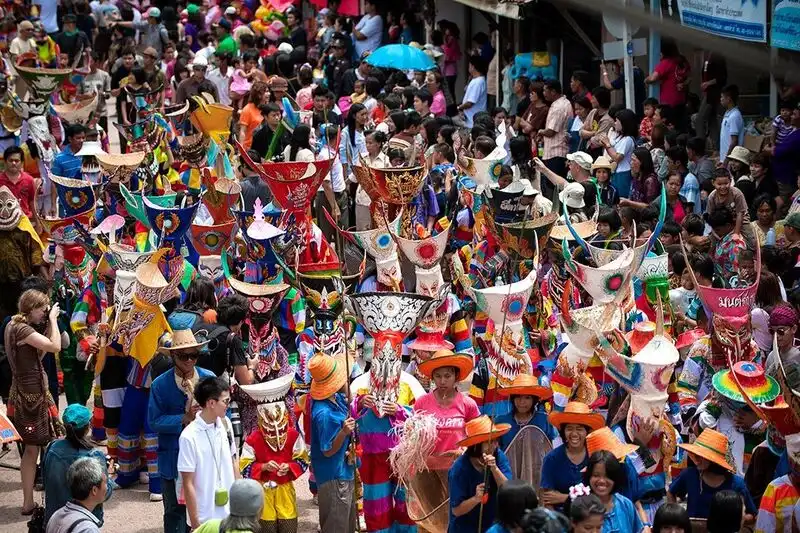
4. The Phi Ta Khon tradition in Loei Province is held during May-June every year. The ceremony lasts for 2 days: on the first day (Wan Hom), the Phi Ta Khon procession will parade around the village since early morning to invite Phra Upakut to stay at the temple. On the second day, there is a procession of Phra Vessantara and Nang Matree into the city, assuming that the temple is a city. On the second day of this event, the villagers also bring rockets to join the procession as a rain-asking ceremony by parading around the temple 3 times. While the procession is taking place, the Phi Ta Khon performers will play tricks on the people to create fun. After the procession is over, the Phi Ta Khon performers will take the Phi Ta Khon performances and equipment used in the ceremony to float down the Man River. In the evening of the same day, there will be a sermon of all 13 Mahachat stories.
5. Chanthaburi Fruit Festival, Chanthaburi Province.
6. World Durian Day Festival, Chanthaburi Province.
July
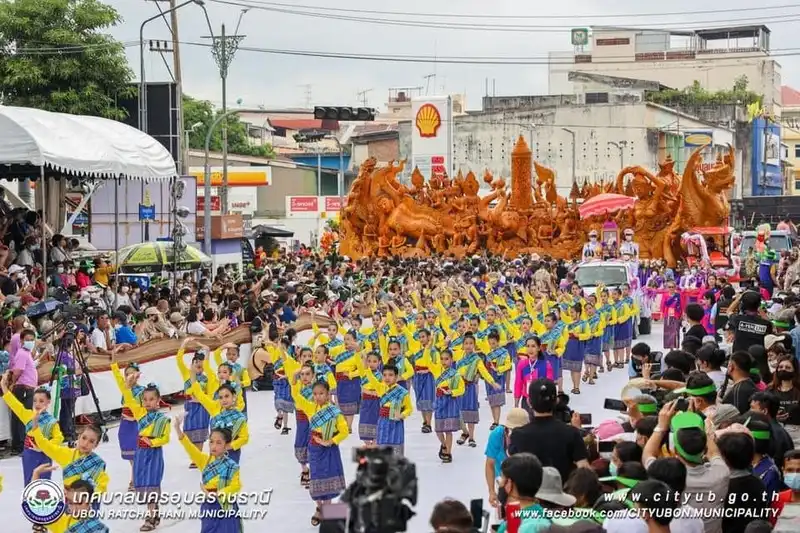
1. The Candle Procession in Ubon Ratchathani Province is a great merit-making tradition of Ubon Ratchathani Province for a long time. Buddhist Lent Day is an important day in Buddhism that continues from Asarnha Bucha Day. There will be a tradition of offering candles during Buddhist Lent. It is a traditional event that unites the bonds of local communities. It starts with villagers donating candles to be melted and molded into one big candle.
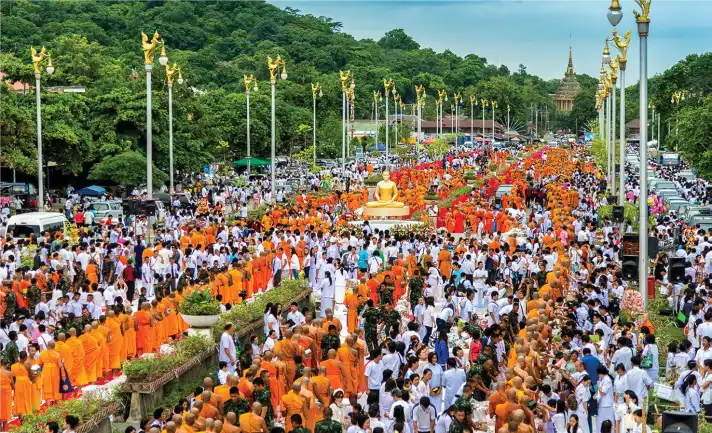
2. The tradition of offering flowers to monks in Saraburi Province during the Buddhist Lent. Offering flowers to monks or worshiping monks can be done at any time, but what the people of Phra Phutthabat do especially on the Buddhist Lent is that when the rainy season comes, there will be a type of flower growing at the foot of the mountain. This type of flower looks like a fingerroot or turmeric tree, about 1 cubit tall. Some trees have yellow flowers, some have white flowers, and some have purple flowers. This type of flower grows only during the rainy season during the Buddhist Lent. Villagers will collect this type of flower to offer to monks and call this flower the Buddhist Lent flower.
3. Canoe competition and festival of good things, Nakhon Nayok Province.
3. Canoe competition and festival of good things, Nakhon Nayok Province.
4. Pattaya Marathon, Chonburi Province.
August
1. Rambutan Day at Surat Thani School.
2. Chai Nat Pomelo Festival, Chai Nat Province.
3. Cake Festival, Trang Province.
4. Longan Festival and Lamphun's Good Products, Lamphun Province.
5. Fruit Festival in Lang Suan, Chumphon Province.
6. Lanna Flora Festival, Chiang Mai Province.
September
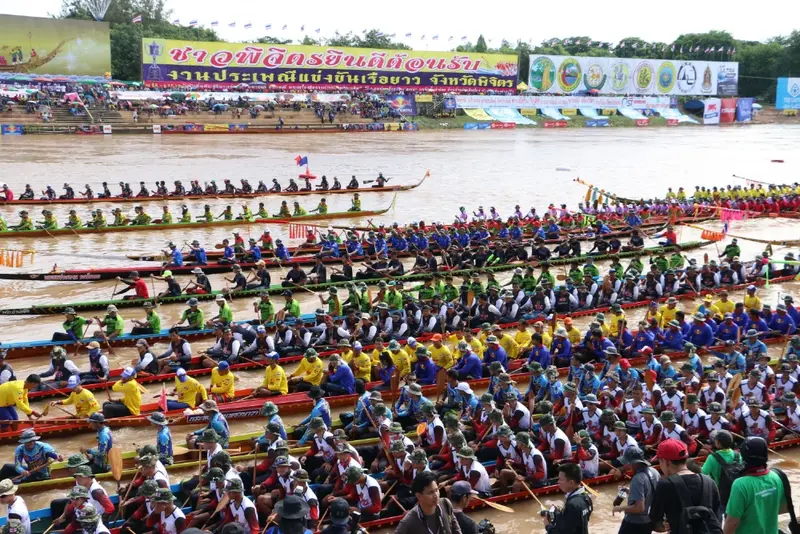
1. Long-tail boat racing tradition, Phichit Province, around September - August, there will be an annual long-tail boat race in front of Wang Klom Temple, Ban Bung Subdistrict. Ban Bung Subdistrict has a long-tail boat, "Ruea Sor Thong", which is a long-tail boat that has won many awards and brought fame to Ban Bung Subdistrict.
2. Narathiwat Good Things Festival, Narathiwat Provinceใ
3. Thai Sarat tradition, Kamphaeng Phet bananas, Kamphaeng Phet Provinceใ
4. Moon Festival, Songkhla Province.
5. Singburi Long-Boat Racing Tradition.
6. Trang Roast Pork Festival, Trang Province.
7. The tradition of the tenth lunar month festival in Nakhon Si Thammarat Province.
8. Longan Sweet Festival and Uttaradit Good Products Festival, Uttaradit Province.
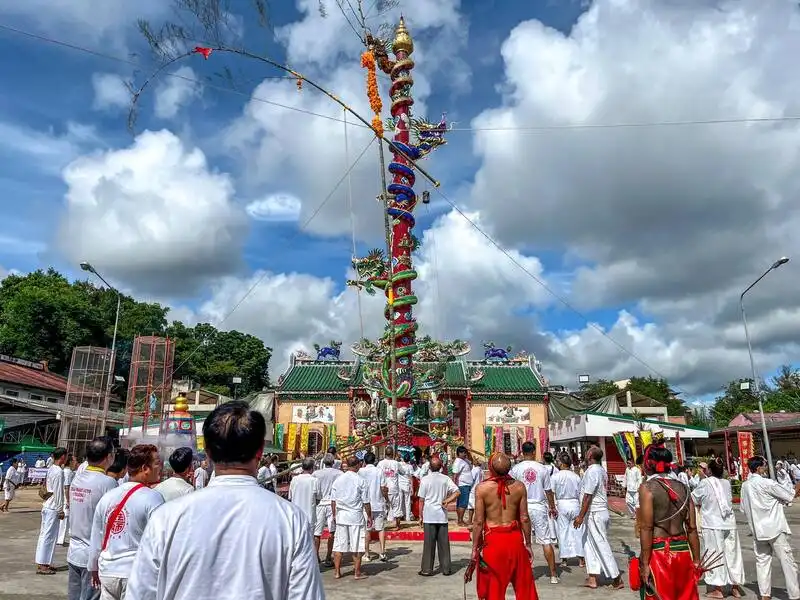
9. Vegetarian Festival, Trang Province The period of Vegetarian Festival of Trang people falls on the 1st to 9th day of the waxing moon of the 9th month of the Chinese calendar (corresponding to the 11th month of the Thai calendar, during September-October every year). Every shrine will set a date for eating vegetarian food at the same time. The ceremony will be held at the shrine of each shrine. The Vegetarian Festival is a tradition that combines many different beliefs, including Taoism, Confucianism, deism, and Mahayana Buddhism. The Vegetarian Festival is a ceremony that expresses the abstinence from killing animals and abstaining from all vices. It is a ceremony that creates unity among the members who come to the ceremony.
10. Long-tail boat racing tradition for the Royal Trophy, Phitsanulok Province.
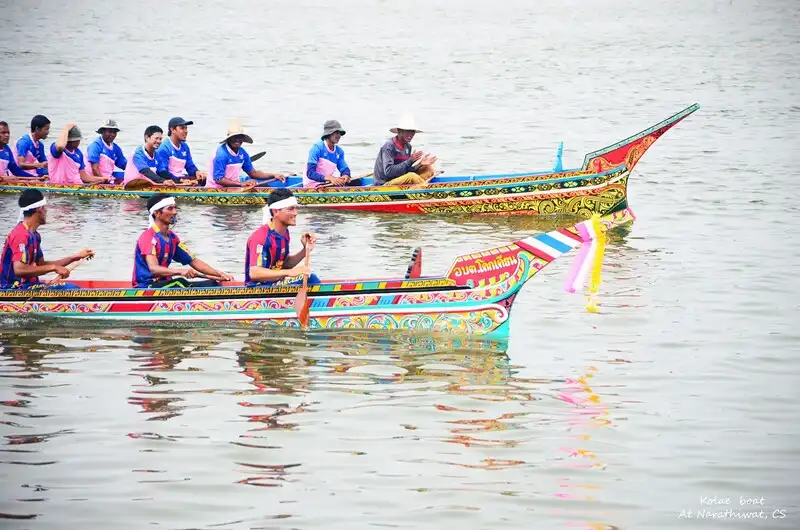
11. The Kor-Lae Boat Race for the Royal Trophy in Front of the Royal Throne, Narathiwat Province The tradition of Kor-Lae boat races and long-tail boat races with rowers in front of the royal throne is held annually from September 21-25, which is the period when His Majesty the King and Her Majesty the Queen, along with the royal family, travel to stay at the Thaksin Ratchaniwet Palace. The people of Narathiwat Province agreed that it is appropriate to organize the Kor-Lae boat race, which is an ancient tradition of the people of Narathiwat Province, to present to His Majesty the King to honor his boundless benevolence and to revive the tradition of Kor-Lae boat races with rowers in front of the royal throne.
เดือนOctober
1. Phatthalung Province's traditional boat racing.
2. Vegetarian Festival, Phuket Province.
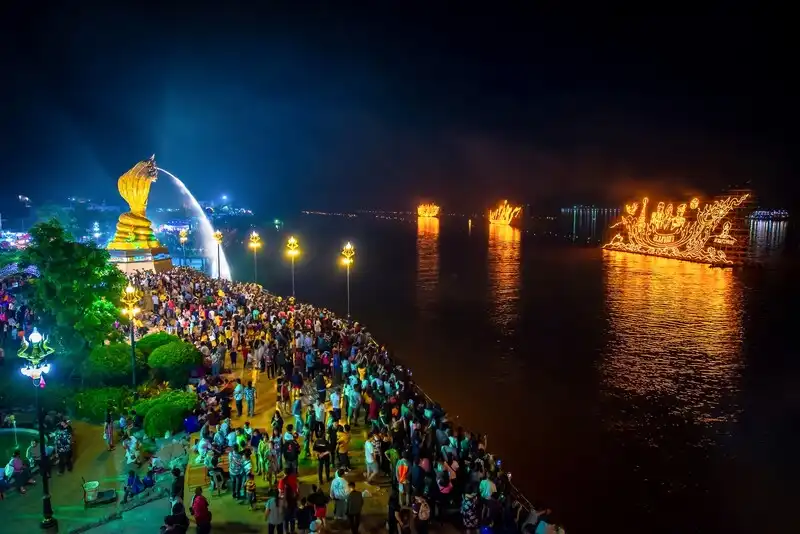
3. Loi Krathong Festival, Maha Sarakham Province Time: The 15th waxing moon of the 11th month to the 1st waning moon of the 11th month (around October) to worship the footprint of the Lord Buddha left on the bank of the Nammatanathi River in the southern region of India, to worship Thao Phakaphrom, to ask for forgiveness from the river for making it dirty, to use fire to burn away all suffering and then float it away with the river.
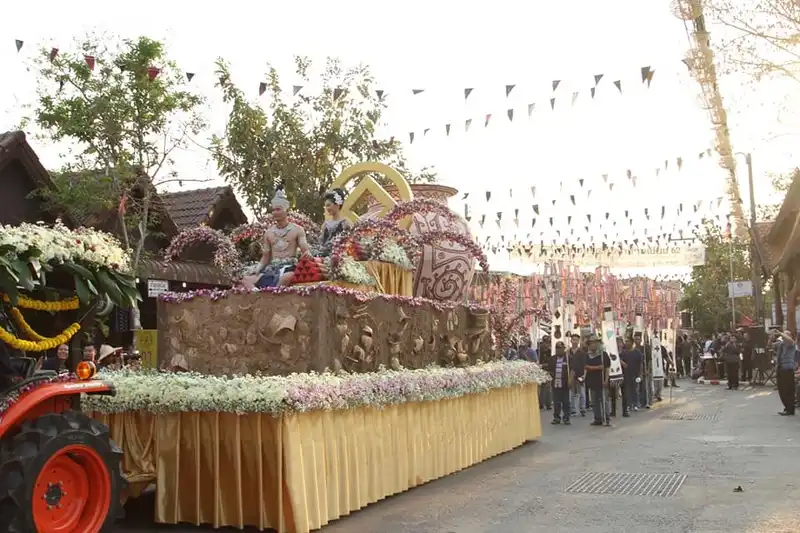
4. Ban Chiang World Heritage Celebration 5,000 Years, Udon Thani Province To celebrate the registration of Ban Chiang civilization as a World Heritage Site and to join in preserving the ancient culture of the Ban Chiang community at Ban Chiang National Museum, Nong Han District, Udon Thani Province, which has been registered as the 359th World Heritage Site.
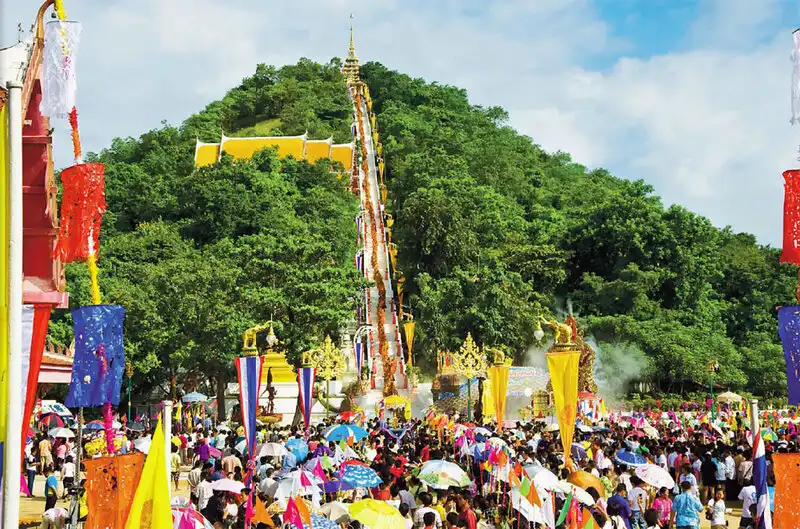
5. Tak Bat Devo Tradition, Uthai Thani Province A period of 1 day on the 1st waning moon of the 11th month (the end of Buddhist Lent) is a traditional event that Uthai Thani people have practiced since the time of their ancestors until it has become a unique identity that all Uthai Thani people are very proud of. Buddhists will join in making merit by offering rice, dried food, and rice balls to the monks in large numbers. In addition to making merit by offering food to monks, there is also a procession of flower floats, with the procession passing through the market and reaching the grounds of Wat Sangkasrattanakiri, where the alms are given. In addition, in the market and various government agencies and shops, there are beautifully decorated ivory altars set up in the market.
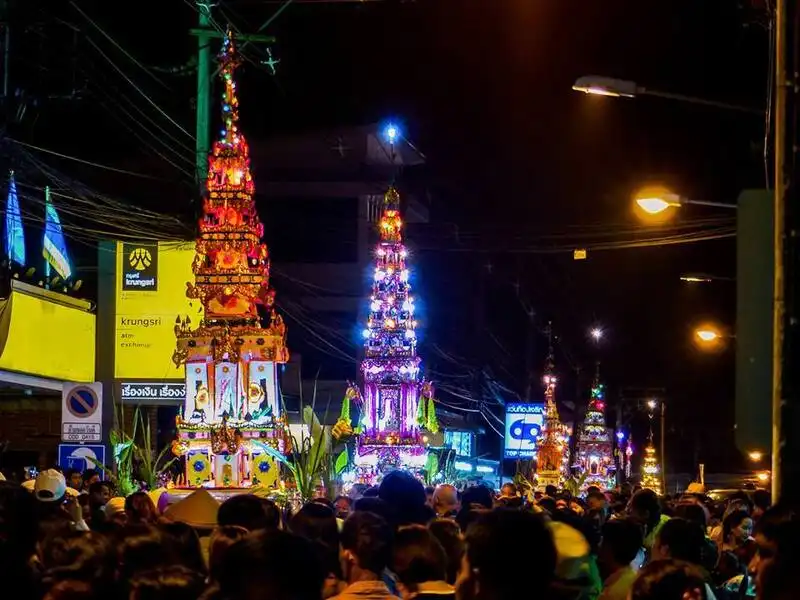
6. Chong Para tradition, Mae Hong Son Province, a tradition part of the Ok Phansa festival (Poi Lin Sip Et festival). The word “Chong Para” is a Shan word meaning “Buddha's Castle”. Worshiping Chong Para means building a castle to welcome the Lord Buddha as he descends from the Tavatimsa heaven. This festival is held between the 15th waxing moon day of the 11th lunar month to the 8th waning moon day of the 11th lunar month.
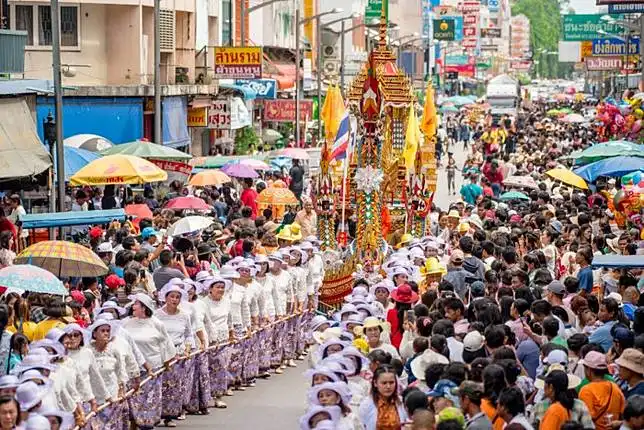
7. The tradition of pulling the Buddha image, making a phaapaa offering, Surat Thani Province. An important tradition of the southern people is the tradition of pulling the Buddha image, making a phaapaa offering, and long-boat racing for the royal trophy.
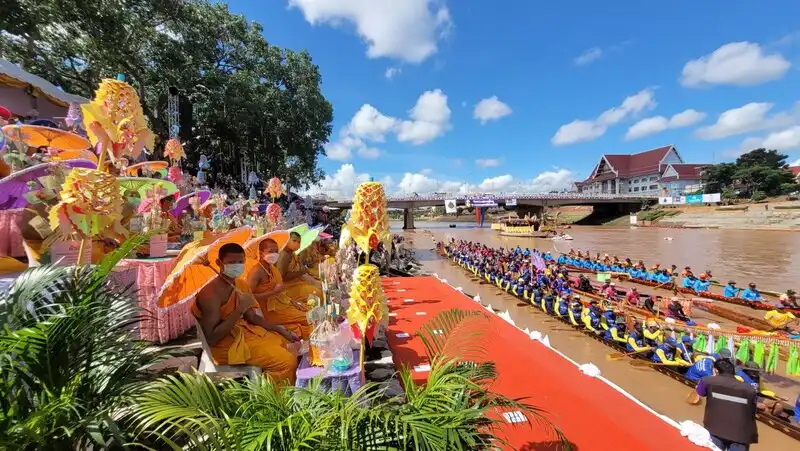
8. The tradition of long-boat racing for the royal trophy in Prachin Buri Province. The tradition of the water procession and long-boat racing is a long-held tradition. It is held every year around September of each year. It is a time when people living along the river can pay homage to the guardian deities of the city.
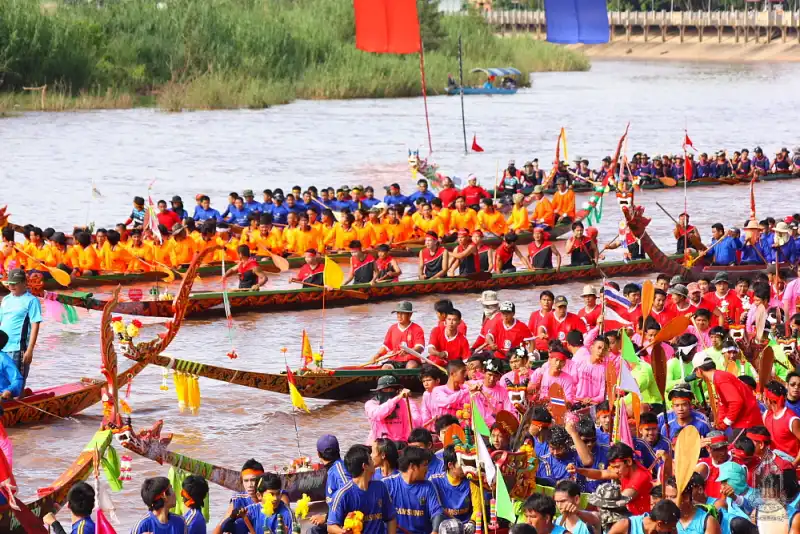
9. Nan Province Boat Racing Tradition Nan Province is a long-boat racing tradition that is held every year around September at the Nan River, Tha Wang Pha Phatthana Bridge, Ban Tha Kham Song, Village No. 7, Rim Subdistrict, to conserve and pass on local traditions.
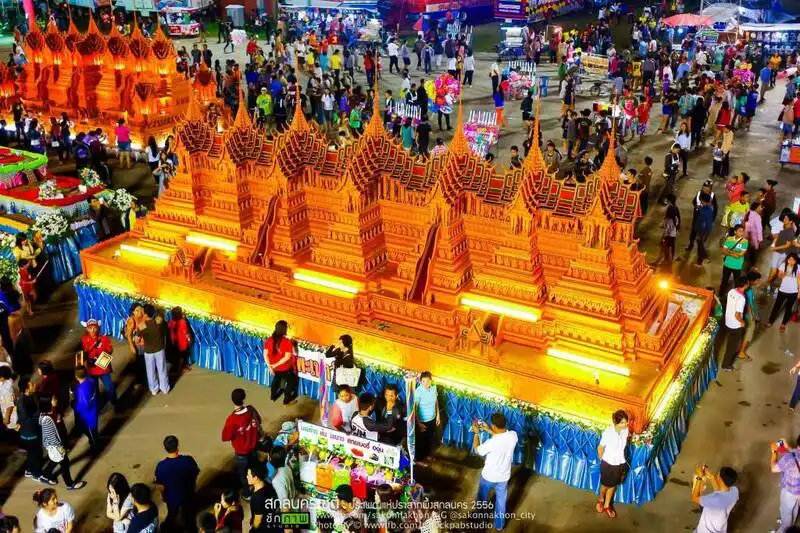
10. The tradition of the end of Buddhist Lent, the procession of the beeswax castle and the long-boat race for the royal trophy, Sakon Nakhon Province, during the festival of the end of Buddhist Lent, the 15th day of the waxing moon of the 11th month. The content of the beeswax castle tradition is mainly about the feelings and minds that have been performed according to the tradition, resulting in mental stability. As for the content of the intention to make merit, it is considered as important as making beeswax castles to offer to the temple. It is considered to gain the highest merit because bees are related to Buddhism, as seen in the life story of the Buddha, the episode of Pali Lai Ling bringing honeycombs to offer to the Lord Buddha, the episode of Thevarohana, where the Lord Buddha performed a miracle to open the world to see each other in all 3 worlds, allowing humans to see the suffering and happiness of gods, humans and the underworld, as well as the episode of Atistana, where the lords, ministers, queens and kings compete to build castles, or even Phra Malai, which is said to be like a castle in heaven.
However, in the essence of the desire for personal merit as mentioned above, there is also the essence of wanting to dedicate merit to the deceased, which may have come from the beliefs of Chinese people who make a living in Sakon Nakhon, who scoop up the shape of a house and burn it to dedicate to the deceased. But if it is modified to build a building in the shape of a ghost hall, decorated with beeswax to offer to monks to dedicate to the deceased.
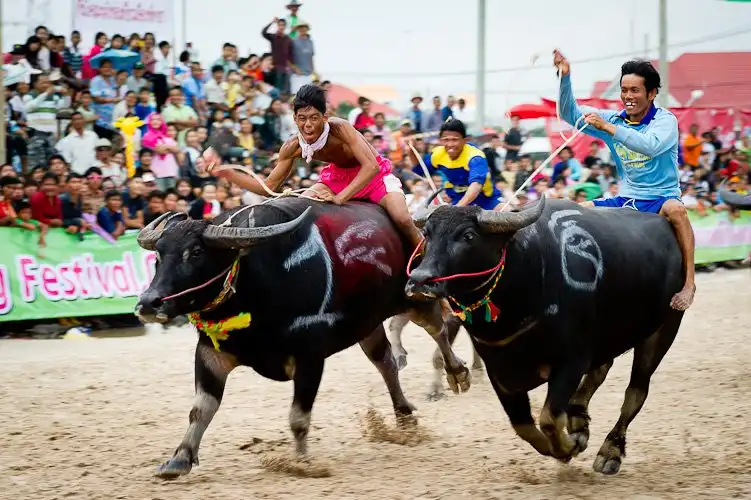
11. The Buffalo Racing Festival in Chonburi Province is a tradition that has been passed down for a long time. The festival begins in October, when the harvest season is over. The Buffalo Racing Festival of Nong Chak Subdistrict is held around October every year. There are many different entertainments in the festival.
November
1. Andaman Sky Opening Ceremony, Krabi Province
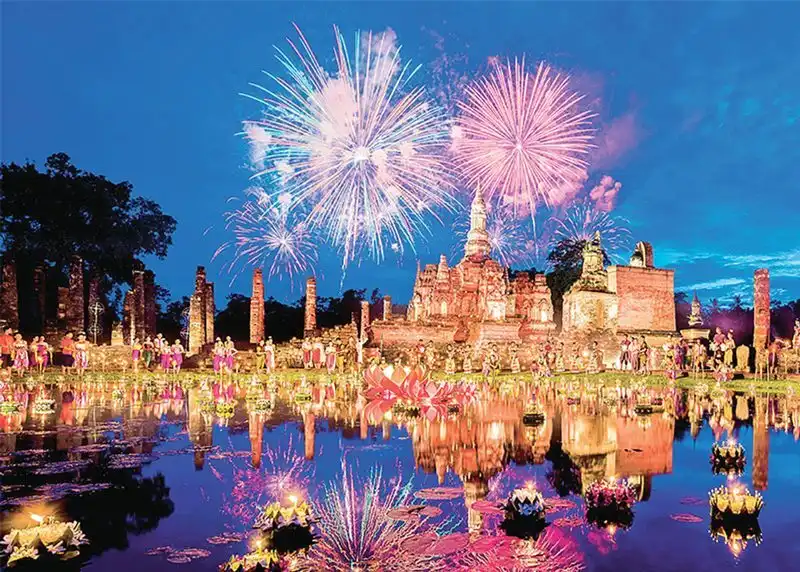
2. Loi Krathong, Candle Festival, and Firework Festival in Sukhothai Province During the 15th day of the waxing moon of the 12th lunar month of every year, this tradition has continued to the Ayutthaya and Rattanakosin eras. Until 1977, Sukhothai Province, together with the Department of Fine Arts and Tourism, revived the Loi Krathong tradition, called the Loi Krathong, Candle Festival, which has become famous and has received a lot of attention from both Thais and foreigners. This is to show gratitude for the kindness of various water sources, including asking for forgiveness for any actions that may have caused those water sources to be unclean. Being grateful and asking for forgiveness is considered a good Thai culture.
3. The tradition of floating a bamboo boat in Wiang Lakon, Lampang Province
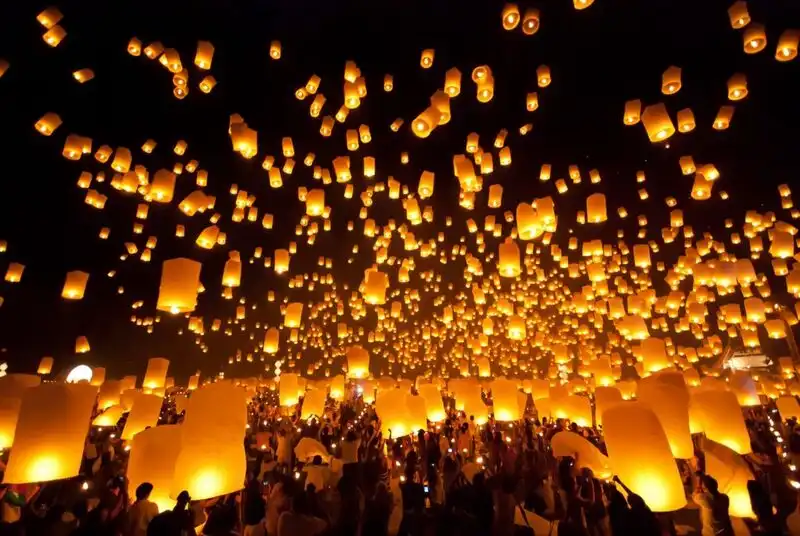

4. Yi Peng Lantern Festival in Chiang Mai Province, a grand traditional festival of the Lanna region that has been practiced since ancient times or the full moon day of the second lunar month of the Lanna people, falls on the full moon day of the 12th lunar month of the central region, which is the end of the rainy season, the beginning of the winter season, the weather is clear and the sky is bright. Another tradition of the Lanna people, apart from floating the krathongs in the river, is to light lanterns to float up and shine brightly in the sky, with the belief that it is to worship the Phra Ket Kaew Chulamani in heaven, or some believe that it is to float away bad luck or to avert bad luck to bring good fortune to life.
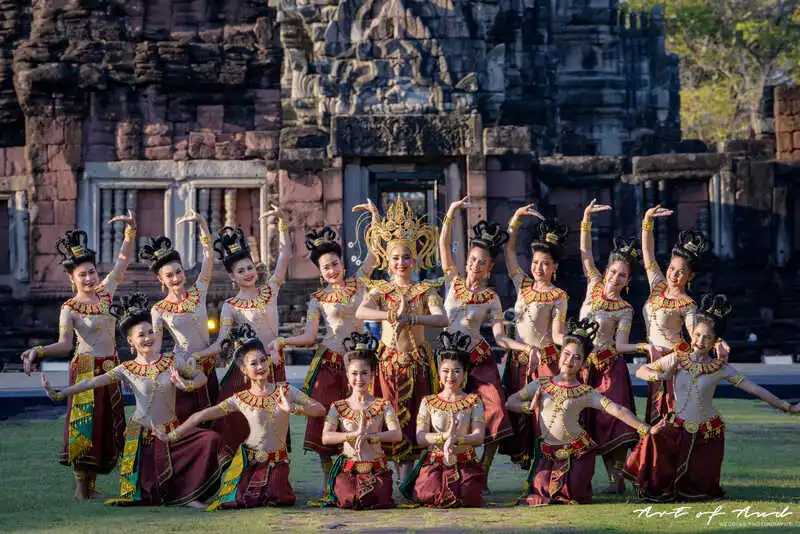
5. Phimai Festival, Nakhon Ratchasima Province Phimai Festival is held around November. There is a spectacular light and sound show in the area around Phimai Historical Park and a long-boat racing tradition on the Chakkarat River in front of the entrance to Phimai Stone Castle.
6. Loi Krathong tradition at the Bang Sai Arts and Crafts Center, Phra Nakhon Si Ayutthaya Province.
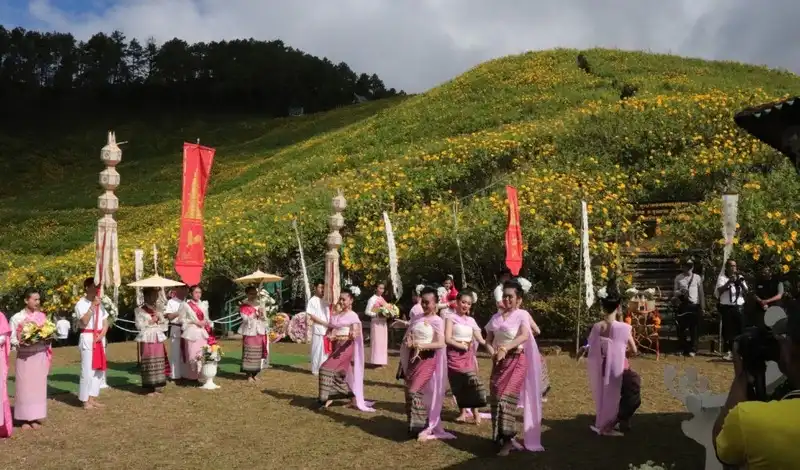
7. Mae Hong Son Sunflower Festival Sunflower Festival is held around November every year. “Sunflower” is a yellow wild flower similar to a sunflower but smaller in size. It usually grows in the high mountain forests of northern Thailand.
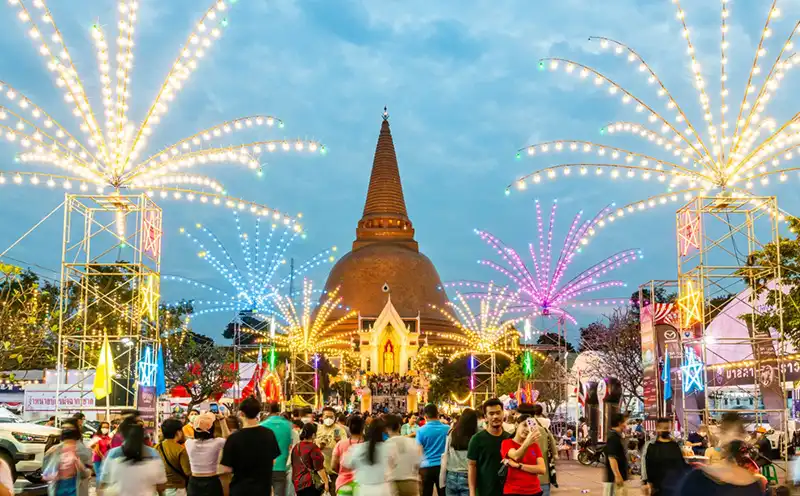
8. The Phra Pathom Chedi Worship Festival in Nakhon Pathom Province is held annually from November 5 to 13. It is a grand 9-day, 9-night temple fair. There are merit-making ceremonies, light shows, music, and other activities. It is a temple fair that adds color to Nakhon Pathom Province.
9. Long-tail boat racing tradition for the royal trophy, Buriram Province.
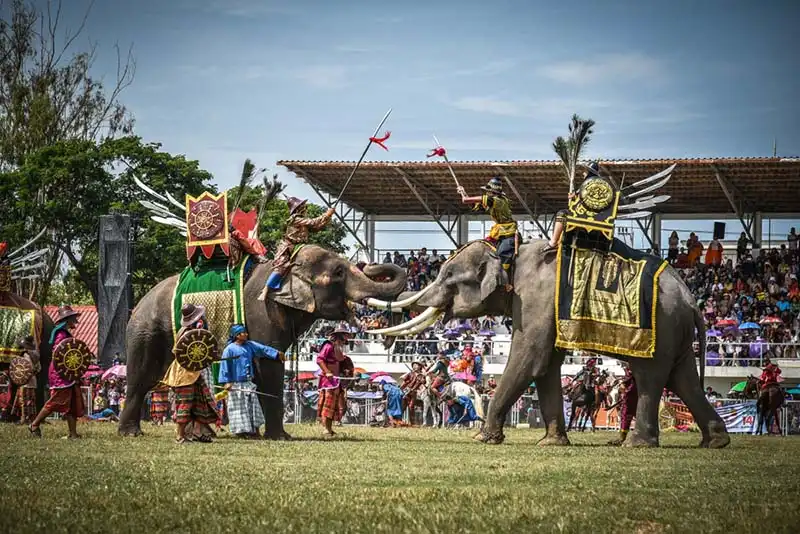
10. Elephant show, Surin Province. Elephant feeding or the world's largest Chinese banquet, approximately 500 meters long. Elephant shows. The elephant show is held for 2 days on the third Saturday and Sunday of November every year. It is a show that gathers the largest number of elephants, up to 200, at the Surin Elephant Show Stadium, which is held from 8:00 a.m. to 12:00 p.m. It is a truly worthwhile show and is filled to the brim every year.
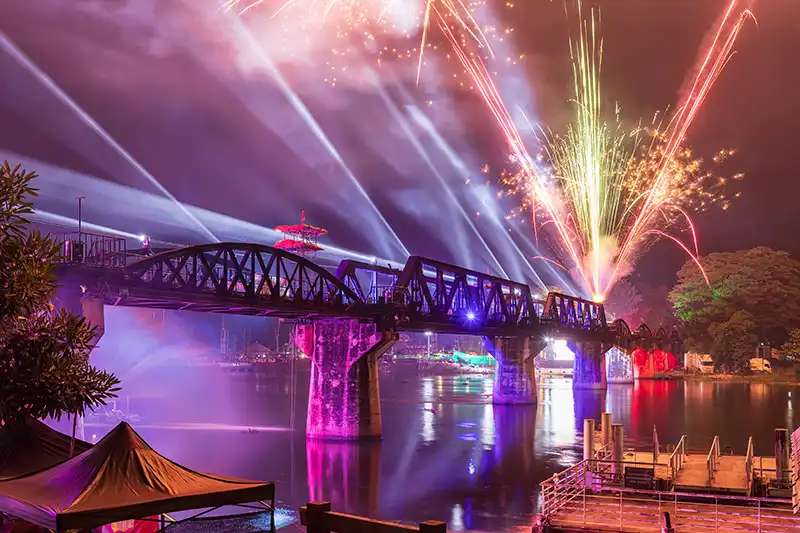
11. River Kwai Bridge Week, Kanchanaburi Province, the event is held around November - December of every year. River Kwai Bridge, Mueang Kanchanaburi District, Kanchanaburi Province. Light and sound show, commemorating the cruelty of building the River Kwai Bridge and the Death Railway, Red Cross booths, exhibitions from agencies, shops, amusement parks and various forms of entertainment.
12. Traditional long-boat racing for the royal trophy, Phra Nakhon Si Ayutthaya Province.
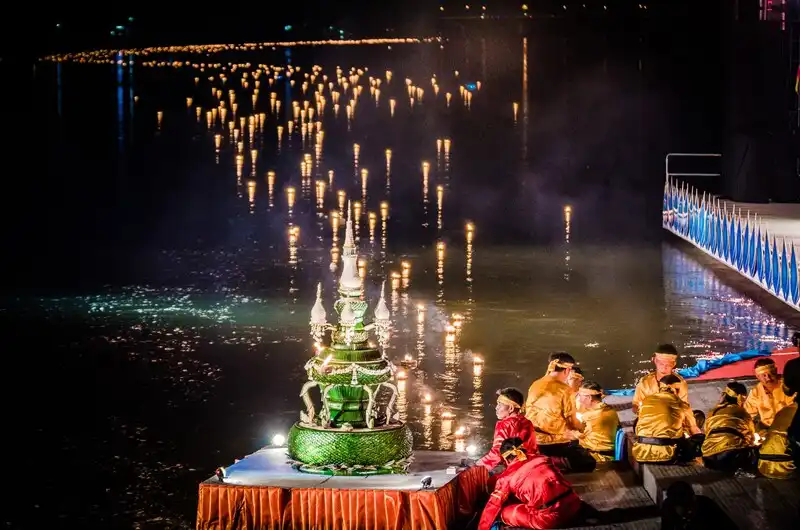
13. Loi Krathong Sai tradition, Tak Province During the full moon day of the twelfth lunar month to worship Mother Ganga, ask for forgiveness for throwing waste into the water and pray to worship the Buddha's footprint. Loi Krathong Sai is a tradition unique to Tak people, which has been practiced for a long time. It shows the unity and friendliness of the villagers in that community.
14. Hua Hin Food Festival, Prachuap Khiri Khan Province.
15. Chinese table banquet for monkeys, Lopburi Province.
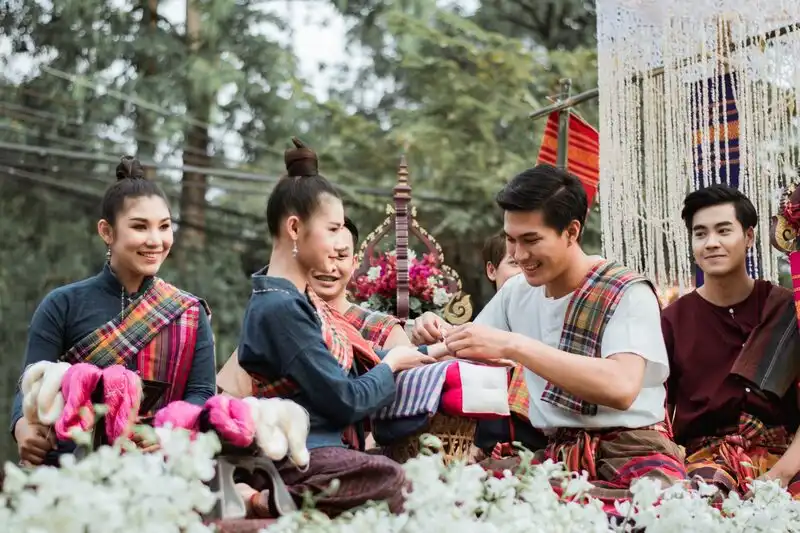
16. Silk Festival, Phik Siew Tradition, Khon Kaen Province Time 29 November - 10 December of every year Phik Siew Tradition is an important tradition held at the same time as the Silk Festival. The purpose is to make local and national people love each other, unite and help each other. The word "Phik Siew" is an Isan dialect meaning true friend, real friend, friend to the end, have a bond, be honest and sincere with each other.
The Silk Festival is an event that Khon Kaen Province has organized every year. It started in 1979 until the present. The objective is to promote the silk weaving career. There are both government and private agencies participating in setting up booths to display products and sell local products (silk) and other souvenirs. In addition, there are also performances to revive and promote local arts and culture.
December
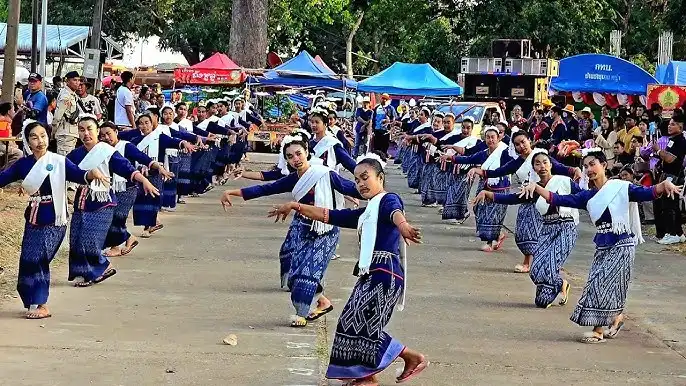
1. The tradition of Heet Sip So and the Red Cross Fair in Amnat Charoen Province is a tradition that the Isan people have practiced since ancient times. The word "Heet" has the same meaning as the word "Reet" which means customs and traditions. Therefore, "Heet Sip Song" means the tradition that the Isan people must practice throughout the twelve months of the year. If anyone violates it, it is considered a crime, called "wrong Heet". The general society will feel disgusted.
2. Chiang Mai Food Festival.
3. Northeastern Kite Festival.
4. Royal Trophy Sailing Competition, Phuket Province.
5. Volcanic crater climbing event, Buriram Province.
6. Andaman Sea Gold Mining Fair, Ranong Province.
7. Ayutthaya World Heritage Fair, Phra Nakhon Si Ayutthaya Province.
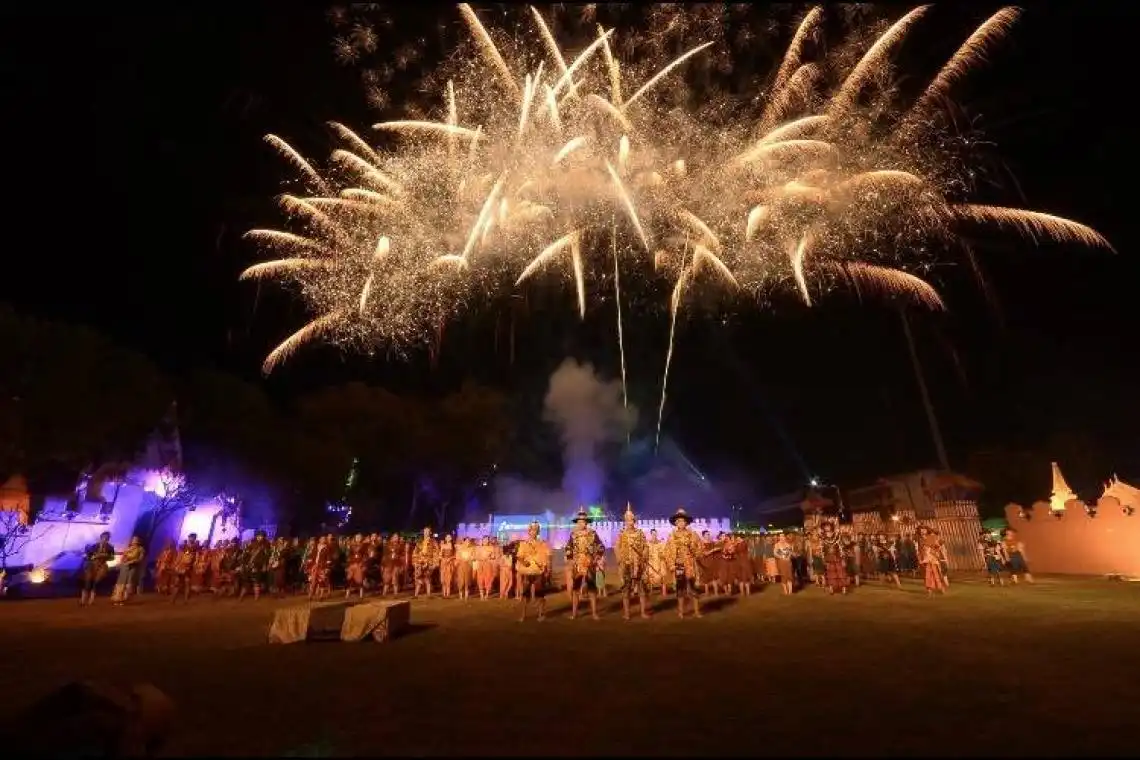
8. Taksin Maharaja Anusorn and Red Cross Fair, Tak Province held between December - January to honor King Taksin the Great and to preserve arts, culture and local traditions. Within the event there will be many booths and entertainment activities, plays with light and sound, sports competitions, country song singing contests, sales of OTOP products, booths by the Red Cross Society of Tak Province, and concerts.
Comment
| Keyword (Advance) |
 Region
Region
|



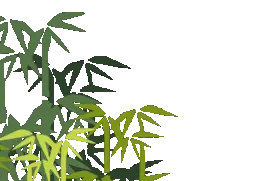



 Category:
Category:  Group:
Group: